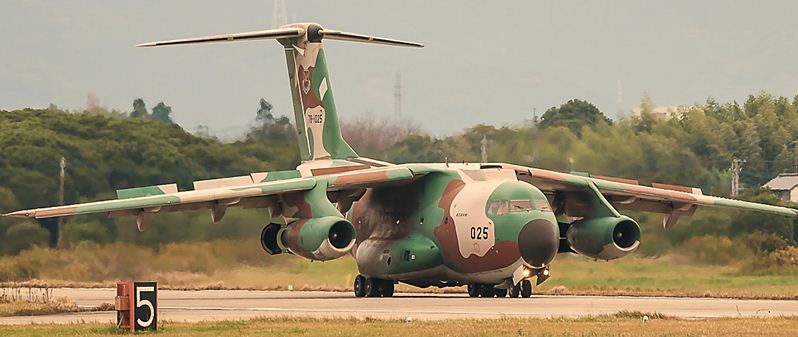 |
| Kawasaki C-1 |
Militarymedia.net - The Kawasaki C-1 is a short-range military transport aircraft, used by the Japan Air Self-Defense Force (JASDF). Development began in 1966. The aircraft was developed to meet the needs of the JASDF to replace previous World War II era transport fleets, such as the Curtis C-46 Commando. The Lockheed C-130 Hercules was initially considered, but instead it was decided to develop a local transport aircraft. Since the Japanese Archipelago does not have a very large geographic area, the JASDF chose short-range aircraft with a relatively light payload. The NAMC (Nihon Aircraft Manufacturing Corporation) consortium was commissioned to develop this aircraft. Kawasaki Heavy Industries is the prime contractor and does most of the work. The XC-1 prototype made its first flight in 1970. Production began in 1971. The first operational aircraft was officially introduced into JASDF service in 1974. Final production of the C-1 model was delivered in 1981. Only 31 airframes were built, not including prototypes and some special aircraft. C-1 was assigned to two formations in the JASDF; Transport Squadrons 402 and 403. In 2014, the JASDF slowly began removing the C-1 from active service. It is planned that they will be replaced with the new Kawasaki C-2 tactical airlifter.
The aircraft has a maximum payload capacity of 11.9 t. The range of this aircraft with a maximum payload is only 1,300 km. The range of this aircraft was deliberately trimmed to maintain the operational range of the aircraft in Japan. This was done in order to comply with Japan's policy of not having offensive capabilities.
The JASDF had planned to acquire more C-1s, but when the US military officially ended its occupation of the Okinawa Islands in 1972, a problem arose; The C-1 had too short a range to carry a useful payload between Kyushu and Okinawa. So the production of C-1 has been reduced. As a result, the JASDF ended up purchasing the American C-130 Hercules tactical transport aircraft, and most of the payment for them was drawn from the C-1 funding.
The C-1 can carry 60 passengers, or 45 paratroopers, or 36 stretchers with medics. A wide variety of loads can be carried thanks to its roll-on, roll-off capability. One light truck or up to three jeeps can also be carried. It is not known whether the C-1 can carry armored vehicles.
It is also planned that the C-1 will be used by the JMSDF for the purpose of laying mines, but it is not clear whether this plan is implemented. It is also unclear whether the aircraft used was a regular C-1, or a special sub-variant (and if the latter was the case, the designation was never made public).
This tactical aircraft only needs 2,200 m to take off from a paved runway, or 1,200 m of runway to land.
This cargo plane is operated by a crew of 5, including two pilots, flight engineer and loadmaster.
The Kawasaki C-1 is powered by two Pratt & Whitney JT8D-M-9 turbofan engines. It is a license manufactured in Japan by Mitsubishi.
The unit cost of the C-1 is $47 Million, although it is only used in Japan, and is not offered for export. Given that production has long since been discontinued, and that the Japanese government has been extremely reluctant to export military hardware, it is doubtful that the C-1 will ever see foreign service.
Several special military variants had been planned, including the reconnaissance and tanker versions, but the aforementioned production cuts effectively led to this failure.
In 2016 the new Kawasaki C-2 started operating with the JASDF. The C-1 formed the design basis for the C-2, although these aircraft were not directly related. The C-2 can carry more cargo (up to 37.6 t) and has a longer range. It will eventually completely replace the Kawasaki C-1 and Lockheed Martin C-130 Hercules tactical cargo planes.
 |
| Kawasaki C-1 |
Kawasaki C-1 Variant
XC-1 prototype for the C-1 series.
C-1, basic production version. 26 of these aircraft were built.
C-1A, has a larger fuel capacity. 5 of these aircraft were built. It is almost certain that this plane was created in response to the Okinawa dilemma.
The EC-1, an electronic warfare variant, is reportedly used for training purposes.
The C-1FTB, a flight test aircraft, is used to test equipment in the air.
The Asuka/QSTOL, an experimental aircraft, was used to evaluate its low-noise features and Short Take-Off and Landing (STOL) capabilities. Only one aircraft was built and is now retired.









